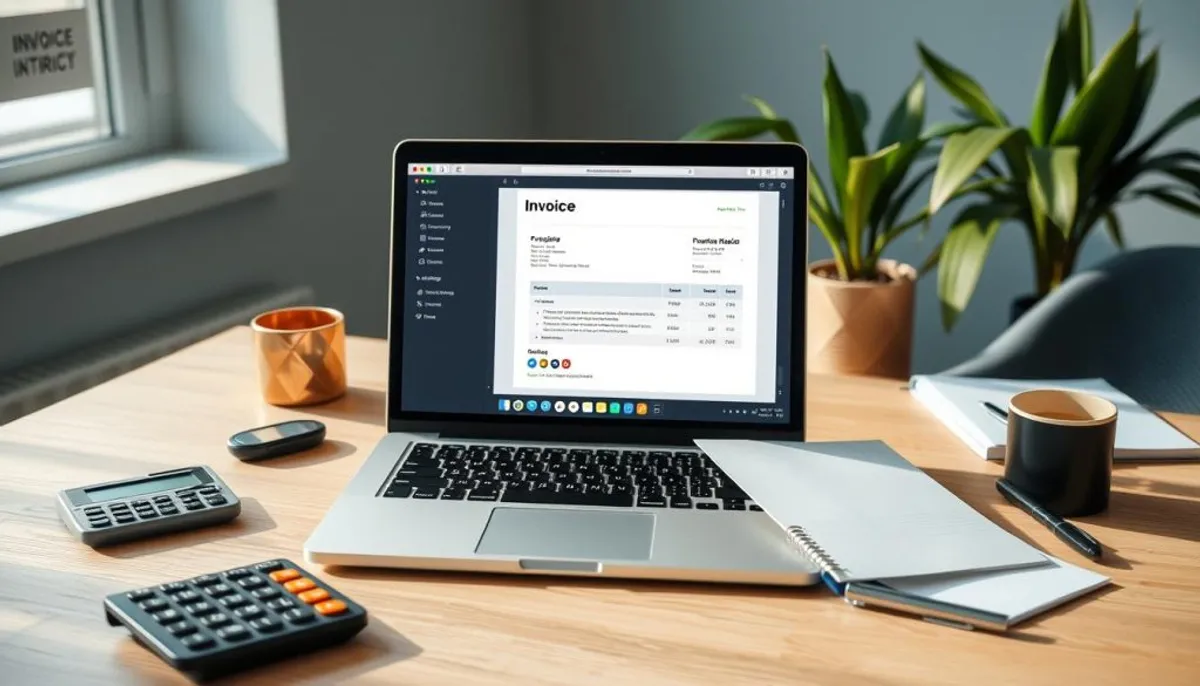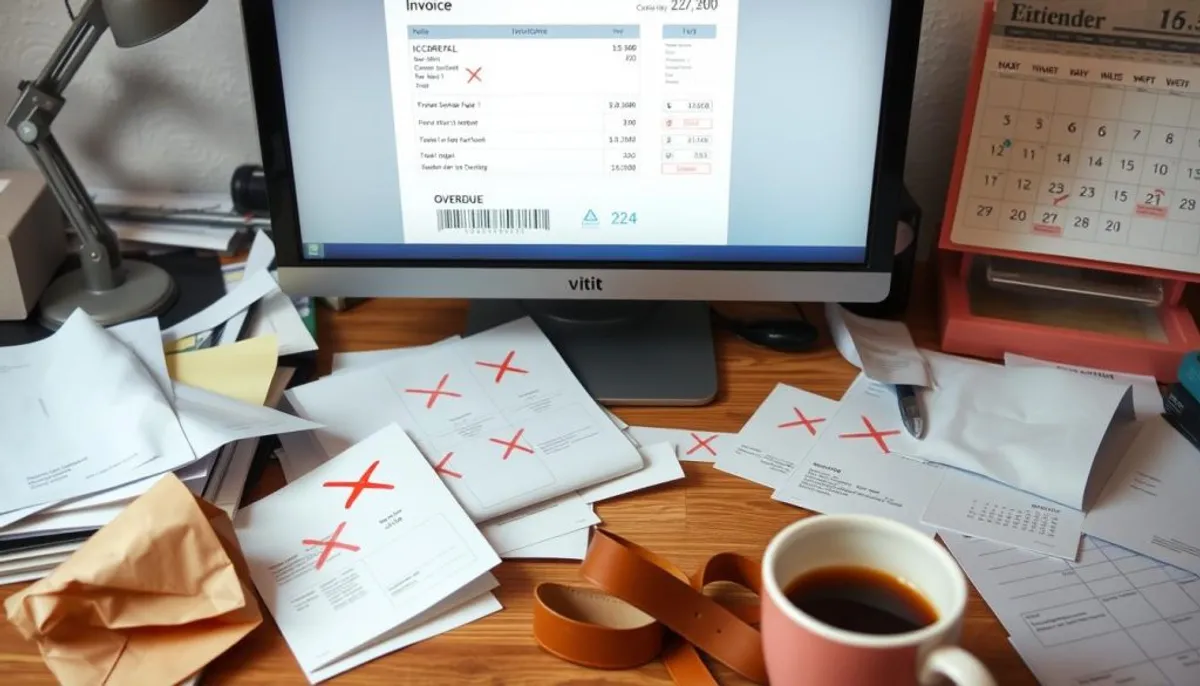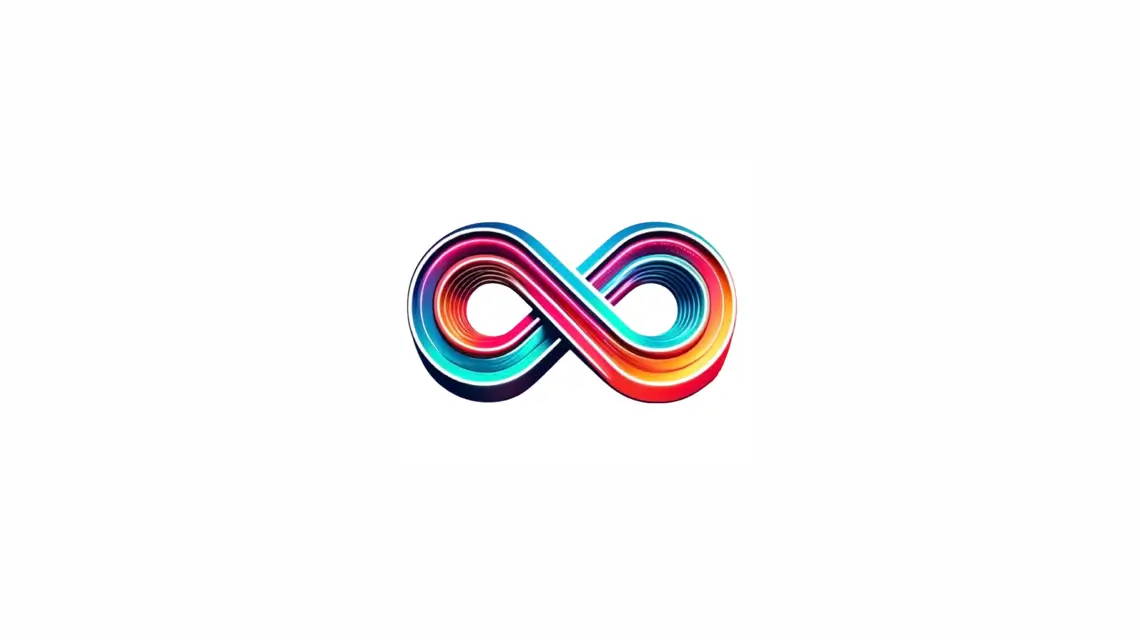In today’s digital landscape, the ability to email invoices efficiently is paramount for businesses of all scales. This guide will introduce you to the fundamentals of digital invoicing. It aims to simplify your billing process and enhance your cash flow.

Online billing has become the standard, and for valid reasons. It’s quicker, more streamlined, and generally more secure than traditional paper invoices. By mastering the art of emailing invoices, you’ll not only save time but also reduce errors and expedite payments.
Digital invoicing brings a plethora of advantages, from instant delivery to enhanced tracking and record-keeping. Whether you’re an independent contractor, a small business owner, or part of a larger entity, grasping the nuances of invoice emails is essential. It’s crucial for maintaining robust business relationships and financial health.
Key Takeaways
- Email invoices save time and improve payment speed
- Clear subject lines and personalized greetings boost response rates
- Attach invoices as PDFs for easy access across devices
- Include all necessary payment details to avoid delays
- Use invoice templates for consistency and efficiency
- Follow up politely but firmly on overdue payments
- Consider automated solutions for streamlined invoicing
Understanding Digital Invoicing Basics
E-invoicing is transforming the billing landscape for businesses. This digital invoicing method surpasses traditional paper-based systems in numerous ways. Let’s dive into the core aspects of electronic invoices and the shift towards paperless billing.
What is Electronic Invoicing
Electronic invoicing, or e-invoicing, involves the digital creation and exchange of invoices between suppliers and buyers. These digital invoices include critical details like date, invoice number, and payment terms. They are often in formats like XML, PDF, or EDIFACT, facilitating seamless processing and storage.
Benefits of Digital Invoicing
Embracing e-invoicing yields significant advantages for businesses:
- Cost savings up to 80% compared to traditional methods
- 50% reduction in invoice processing time
- Improved accuracy and reduced errors
- Enhanced supplier relationships and satisfaction
- Better cash flow management
- Increased security and fraud prevention
Legal Requirements and Compliance
While e-invoicing offers numerous benefits, businesses must comply with legal standards:
| Requirement | Description |
|---|---|
| Digital Signatures | Ensure authenticity and integrity of invoices |
| Secure Transmission | Use encrypted channels to protect sensitive data |
| Data Retention | Store invoices securely for required periods |
| Format Compliance | Use approved digital formats (XML, PDF, etc.) |
By grasping these fundamentals, businesses can harness e-invoicing to enhance operational efficiency, reduce expenses, and meet evolving regulatory demands.
Essential Components of a Professional Invoice
Creating a professional invoice is vital for the smooth operation of any business. Invoicing software and automation tools play a crucial role in streamlining this process. They ensure accuracy and consistency in your financial transactions. Let’s examine the critical components that comprise a well-structured invoice.
A professional invoice begins with a compelling header that captures attention and establishes the invoice’s tone. It should include a unique identifier, such as an invoice number, to distinguish each transaction. Your company’s details must be prominently displayed, featuring your name, address, phone number, email, and tax ID.
Client information is equally crucial. List the payer’s name, company, address, and contact details. Clearly state the due date to simplify tracking of transactions. Provide a detailed breakdown of goods or services sold, including item names, prices, and quantities.
Remember to include any applicable fees or taxes near the pricing information. The total amount due should be clearly visible. Outline accepted payment methods, such as checks, credit cards, or online platforms. Lastly, specify your terms of transaction, including any late payment penalties.
- Include your business logo for a professional touch
- Provide clear business contact information
- Offer multiple payment options (e.g., debit card, credit card, ACH transfer)
- Use invoice automation to track status and send reminders
By incorporating these elements and leveraging invoicing software, you can create polished, efficient invoices. These invoices facilitate prompt payments and foster positive client relationships.
How to Email Invoices Effectively
Emailing invoices is a critical aspect of contemporary business operations, pivotal in cloud invoicing and accounts receivable processes. A meticulously crafted invoice email can expedite payments and uphold professional client relationships.
Creating Clear Subject Lines
Your subject line is the initial point of contact for recipients. It must be impactful, featuring the word “Invoice” alongside the invoice number. This strategy enables clients to swiftly recognize and prioritize your communication.
Writing Professional Email Body Content
The email’s body should be succinct yet comprehensive. It should detail the total amount owed, the payment deadline, and a concise overview of services provided. Adopt a tone that is both friendly and professional to nurture strong client bonds.
Proper Invoice Attachment Methods
It is advisable to attach your invoice as a PDF file. This format guarantees compatibility across various devices and preserves the document’s layout. For those utilizing cloud invoicing software, consider including a secure link for online invoice access.
| Element | Best Practice |
|---|---|
| Subject Line | Include “Invoice” and invoice number |
| Email Body | Brief, professional, with key payment details |
| Attachment | PDF format or secure online link |
| Payment Terms | Clearly stated (e.g., Net 30, Net 45) |
| Follow-up | Polite reminders for overdue payments |
Adhering to these best practices will streamline your accounts receivable workflow and enhance cash flow. Remember, the essence of timely payments and client satisfaction lies in clear communication.
Best Practices for Invoice Email Templates
Creating effective invoice email templates is essential for digital invoicing success. A well-crafted template can streamline your billing process and improve cash flow. Let’s explore key elements of successful invoice email templates.
Template Structure and Design
A professional invoice email template should have a clear structure. Include a friendly greeting, state the purpose, provide an invoice summary, and offer payment instructions. End with a professional signature. This format ensures clarity and professionalism.
Customization Options
Tailor your invoice email templates to reflect your brand identity. Use your company logo, colors, and fonts. Personalize the content based on your relationship with the client. This approach builds trust and reinforces your professional image.
Follow-up Templates
Create separate templates for follow-up emails. These should be polite yet firm. Send follow-ups within 1-3 days after the due date for better payment rates. A consistent follow-up strategy can significantly improve your collection process.
| Template Type | Key Elements | Timing |
|---|---|---|
| Initial Invoice | Greeting, Purpose, Summary, Instructions | 7-28 days before due date |
| First Follow-up | Friendly Reminder, Invoice Details | 1-3 days after due date |
| Second Follow-up | Firm Tone, Payment Options | 7 days after first follow-up |
By implementing these best practices for invoice email templates, you can enhance your digital invoicing process. Remember, consistency and professionalism in your templates build trust and credibility with clients, leading to timelier payments and improved cash flow.
Streamlining Payment Collection with ti3
Managing overdue accounts can be a significant challenge for businesses. ti3 offers a solution to streamline payment collection and tackle unpaid invoices effectively. This SaaS platform automates the entire process, from sending reminders to escalating issues and collecting payments.
Businesses face difficulties with late payments, as evidenced by alarming statistics. A staggering 49% of invoices issued by US companies become overdue, and 33% remain unpaid for a month. This delay can severely impact cash flow, with 89% of SMBs reporting that late payments hinder growth.
ti3 addresses these challenges by providing an efficient alternative to traditional debt collection methods. It helps maintain positive client relationships while improving cash flow. The platform’s automated approach significantly reduces the time spent on payment collection tasks, which typically consume 14 hours per week for 65% of businesses.
| Manual Invoice Processing | Automated Invoice Processing (ti3) |
|---|---|
| $12 average cost per invoice | 60-80% reduction in expenses |
| 30+ days average payment time | 14 days average payment time |
| 1% error rate per 1,000 invoices | 66% reduction in errors |
| 30% of unpaid bills need 3+ reminders | Automated reminders and escalation |
By leveraging ti3’s automated solutions, businesses can expect faster payments, reduced errors, and improved cash flow. This cost-effective approach not only saves time but also increases the likelihood of receiving payments on time, crucial for sustainable business growth.
Common Mistakes to Avoid When Sending Invoice Emails
Sending invoice emails can be a complex task. We will explore common pitfalls and strategies to sidestep them. By steering clear of these errors, you enhance your likelihood of timely payment.
Formatting Errors
Poor formatting can undermine the professionalism of your invoice. Employ a consistent font and layout. Ensure all critical details, such as itemized charges, due date, and payment terms, are included. A well-structured invoice, adorned with polite language, is 12% more likely to be settled within 7 days.
Communication Pitfalls
Effective communication is paramount. Avoid a tone that is too casual. Offer clear payment instructions. Craft a professional subject line that clearly states “Invoice” and the invoice number. Incorporating polite expressions like “please” and “thank you” can expedite payments by 12%.
Technical Issues
Technical hitches can significantly delay payment. Verify that all attachments are accessible and links are operational. Leveraging invoicing software can circumvent common errors, such as duplicate invoices, which account for nearly 10% of all invoices. This measure prevents unnecessary payments exceeding $42 million annually.

Invoicing software automates the process, reducing costs to $13 per invoice. It also mitigates calculation errors prevalent in manual invoicing. Digital copies are preferred for record-keeping. Always verify recipient details to avoid sending invoices to the wrong buyer.
Security Considerations for Electronic Invoicing
In today’s digital world, safeguarding invoices is crucial. The UK saw nearly £82 million lost to invoice redirection fraud last year. This highlights the need for robust secure billing practices. The transition to electronic invoicing, accelerated by lockdowns, has heightened the risk of spear phishing attacks.
Enhancing invoice security involves leveraging dedicated invoicing software or Electronic Invoice Presentment and Payment (EIPP) platforms. These tools offer security standards akin to online banking, safeguarding critical financial information. They also provide real-time updates on invoice delivery and receipt, facilitating timely payment reminders.
When selecting invoicing solutions, focus on these essential security features:
- PDF invoices with digital signatures for verification
- Secure online payment options (credit cards, PayPal)
- Individual login credentials for each customer account
- Single sign-on technology for admin users
Adopting these secure billing practices can drastically lower fraud risks and protect financial confidentiality. Remember, investing in invoice security is not merely about financial protection. It’s also about preserving your reputation and earning customer trust.
Automated Invoice Email Solutions
Invoicing software and invoice automation have transformed the billing landscape for businesses. These innovations streamline processes, conserve time, and diminish errors. We will examine some leading options, their integration capabilities, and cost assessments.
Popular Invoicing Software Options
HighRadius EIPP Software is a preferred choice for many enterprises. It significantly enhances efficiency and promotes electronic payment adoption by 30%. This tool also boosts invoicing productivity by 50% and ensures global compliance.
Integration Capabilities
HighRadius EIPP Solution integrates effortlessly with prominent banks like BofA, Citi, PNC, Chase, Wells Fargo, HSBC, and ING. It complies with critical standards such as GDPR, ISO, PCI DSS, HIPAA, and SOC to safeguard financial data.
Cost Comparison
Though pricing varies, the benefits of invoice automation are evident. HighRadius EIPP Software promises implementation and ROI realization within 3 to 6 months. A notable example shows a company’s financial services costs plummeted by $2.5M, while experiencing a surge in volume, quality, and productivity.
| Feature | HighRadius EIPP | Other Solutions |
|---|---|---|
| Electronic Payment Adoption | 30% increase | Varies |
| Invoicing Productivity | 50% increase | Varies |
| ROI Realization | 3-6 months | Often longer |
| Bank Integration | Major banks included | Limited options |
Selecting the appropriate invoicing software is crucial for enhancing business efficiency and profitability. Assess your specific requirements, integration needs, and budget to make an informed choice.
Managing Late Payments and Follow-ups
Late payments can significantly impact your business. A study by Sage reveals that global businesses lose over $3 trillion due to late payments. With 1 in 10 invoices not paid on time, it’s crucial to have effective strategies for managing overdue accounts.
Reminder Strategies
Implementing a structured approach to payment reminders can improve your collection rates. Start with friendly reminders before the due date, then escalate to more formal follow-ups after the deadline. Many businesses use a 30, 60, 90 days past due invoice email sequence, but you can tailor this to your needs.
- Day 1: Send a polite reminder
- Day 15: Follow up with a friendly nudge
- Day 30: Issue a formal notice

Escalation Procedures
When an account reaches 60 or more days overdue, the likelihood of payment drops significantly. At 90 days, there’s a real risk of non-payment. To mitigate this, consider implementing escalation procedures:
- Apply late fees after a specific time window
- Offer discounts for early or on-time payments
- Provide incentives like coupons for consistent on-time payments
- Consider suspending services for persistent non-payment
Remember, maintaining professionalism throughout the process is key to preserving client relationships while ensuring timely payments.
| Days Overdue | Action | Potential Outcome |
|---|---|---|
| 0-30 | Friendly reminder | 50% payment rate |
| 31-60 | Formal notice | 30% payment rate |
| 61-90 | Final warning | 15% payment rate |
| 90+ | Legal action | 5% payment rate |
International Invoice Email Considerations
Engaging in global billing introduces distinct challenges for businesses. The sheer volume of $7 trillion in annual International Accounts Payable underscores the need to address currency conversions, local tax regulations, and cultural nuances in business communication.
When sending invoices to clients abroad, it’s imperative to specify the currency and applicable exchange rates. Traditional bank wire transfers, costing around $35 per transaction, can take up to 5 days to settle. To expedite this, consider adopting a sophisticated AP automation platform. Such platforms can manage multi-currency invoices and facilitate payments within 1-2 days.
Key considerations for international invoicing include:
- Currency conversion and exchange rates
- Local tax regulations and compliance
- Cultural differences in business communication
- Payment processing times and fees
Automated platforms can eliminate intermediary fees, ensuring vendors receive the exact payment amount. They also offer real-time payment status tracking. These solutions often integrate with ERPs, providing transparency and simplifying the reconciliation of international invoices. By utilizing these tools, businesses can efficiently manage global billing and foster robust relationships with international clients.
Conclusion
Mastering the art of emailing invoices is a transformative step for businesses aiming to streamline their digital invoicing process. By adopting best practices, companies can notably enhance their chances of receiving timely payments. For instance, sending invoice emails promptly after completing work significantly increases the likelihood of on-time payment.
Crafting clear subject lines, personalizing messages, and including essential details like invoice numbers and payment terms are critical steps in effective online billing. Studies indicate that informative subject lines can prompt customers to pay promptly. It is also important to attach invoices in easily readable formats, such as PDF, to enhance customer convenience.
Utilizing automated invoice email solutions and integrating various payment options can further simplify the process. By maintaining a professional yet friendly tone and expressing gratitude, businesses can foster positive client relationships. Regular follow-ups and tailored email templates for different scenarios help manage cash flow efficiently. With these strategies, companies can perfect their email invoices approach and enjoy smoother financial operations.
RelatedRelated articles



